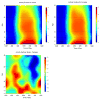Re-evaluating the effect of age on physical activity over the lifespan
- PMID: 28579498
- PMCID: PMC5541765
- DOI: 10.1016/j.ypmed.2017.05.030
Re-evaluating the effect of age on physical activity over the lifespan
Abstract
Advancements in accelerometer analytic and visualization techniques allow researchers to more precisely identify and compare critical periods of physical activity (PA) decline by age across the lifespan, and describe how daily PA patterns may vary across age groups. We used accelerometer data from the 2003-2006 cohorts of the National Health and Nutrition Examination Survey (NHANES) (n=12,529) to quantify total PA as well as PA by intensity across the lifespan using sex-stratified, age specific percentile curves constructed using generalized additive models. We additionally estimated minute-to-minute diurnal PA using smoothed bivariate surfaces. We found that from childhood to adolescence (ages 6-19) across sex, PA is sharply lower by age partially due to a later initiation of morning PA. Total PA levels, at age 19 are comparable to levels at age 60. Contrary to prior evidence, during young adulthood (ages 20-30) total and light intensity PA increases by age and then stabilizes during midlife (ages 31-59) partially due to an earlier initiation of morning PA. We additionally found that males compared to females have an earlier lowering in PA by age at midlife and lower total PA, higher sedentary behavior, and lower light intensity PA in older adulthood; these trends seem to be driven by lower PA in the afternoon compared to females. Our results suggest a re-evaluation of how emerging adulthood may affect PA levels and the importance of considering time of day and sex differences when developing PA interventions.
Keywords: Accelerometer; Diurnal; Gender; Lifespan; NHANES; Physical activity; Sex differences.
Copyright © 2017 Elsevier Inc. All rights reserved.
Figures



Comment in
-
Total volume of physical activity: TAC, TLAC or TAC(λ).Prev Med. 2018 Jan;106:233-235. doi: 10.1016/j.ypmed.2017.10.028. Epub 2017 Nov 11. Prev Med. 2018. PMID: 29080825 Free PMC article. No abstract available.
-
In response to: Re-evaluating the effect of age on physical activity over the lifespan.Prev Med. 2018 Jan;106:231-232. doi: 10.1016/j.ypmed.2017.09.003. Epub 2017 Nov 21. Prev Med. 2018. PMID: 29169827 No abstract available.
References
-
- Healthy People 2020. Washington, DC: Office of Disease Prevention and Health Promotion. United States Department of Health and Human Services; 2010.
-
- Physical Activity Guidelines Advisory Committee Report. Washington D.C: United States Department of Health and Human services; 2008.
-
- Troiano RP, Berrigan D, Dodd KW, Masse LC, Tilert T, McDowell M. Physical activity in the United States measured by accelerometer. Medicine and science in sports and exercise. 2008 Jan;40(1):181–188. - PubMed
-
- Sallis JF. Age-related decline in physical activity: a synthesis of human and animal studies. Medicine and science in sports and exercise. 2000 Sep;32(9):1598–1600. - PubMed
MeSH terms
Grants and funding
LinkOut - more resources
Full Text Sources
Other Literature Sources
Medical

